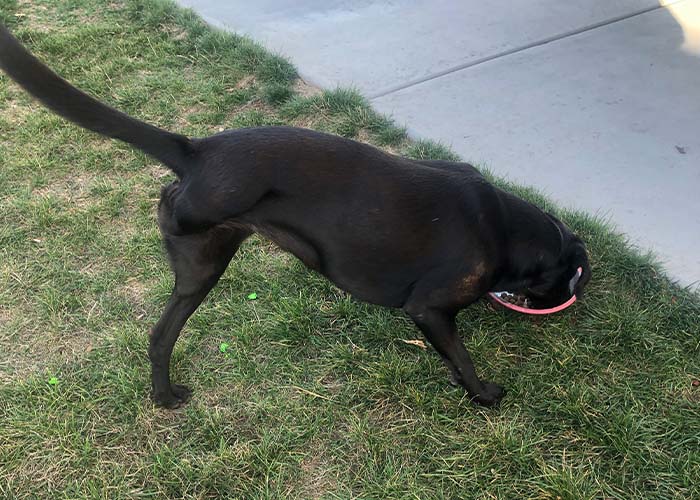
An amputation is a surgical procedure where a pet’s limb is removed. An amputation may be performed due to a variety of reasons which may include a cancer diagnosis, severe trauma, fractures, infections, or chronic pain. Typically, an amputation of the forelimb includes removal of the entire limb leaving an incision line over the side of the chest. A hindlimb amputation includes removal of the limb at the hip joint or top portion of the thigh bone (femur). In special cases, an amputation may be modified to fit a prosthetic limb in patients that can’t tolerate walking on three legs.
What to expect before amputation surgery
Prior to an amputation, your pet will be evaluated to identify any co-factors that may influence their recovery from surgery. Other orthopedic problems, neurologic conditions, or conditions that limit mobility can influence recovery speed or ease but don’t always disqualify pets from being an amputation candidate. Obese patients will benefit from weight loss if feasible prior to surgery. Dogs with additional mobility issues or obesity may require post-operative walking assistance or physical therapy.
A common misconception is that giant breed dogs are not amputation candidates. Amputations in giant breed dogs are frequently performed with proper pre-operative screening and can have excellent outcomes with proper post-operative rehabilitation.
What to expect the day of surgery
Prior to surgery, your pet will undergo pre-operative tests to ensure a safe protocol for general anesthesia. At surgery, they’ll receive a “bad haircut” that includes shaving a large area around the limb to be removed. After limb removal, intravenous medications are administered to alleviate pain. In some cases, the limb will be submitted to a lab for evaluation if there is suspicion of cancer or infection.
Over the next few days, pain medications are transitioned to oral administration in preparation for your pet to be discharged from the hospital. Patients are discharged with instructions for activity restriction, incisional monitoring, medication administration, and how to assist with mobility.
What to expect during recovery from amputation surgery
Typical post-operative recovery from an amputation is approximately two weeks until the site is healed. Dogs and cats carry slightly more weight on the forelimbs than the hindlimbs, so recovery from a hindlimb amputation may not require as much assistance during recovery. Complications or mobility issues may prolong recovery. Infrequent complications may include those related to anesthesia, incisional irritation or infection, bleeding, or fluid build-up at surgical site.
Long-term, patient quality of life is great following an amputation. Most amputees have no long-term limitations or pain. Additional rehabilitation therapy can be helpful in the transition phase after surgery to strength other limb muscles. Amputees frequently run, jog with their owners, swim, and jump on and off the couch with ease. Future injuries to remaining limbs can be more difficult to recover from, however, most pets are quite resilient.
Alternatives to amputation
Alternatives to a complete amputation include partial amputation with prosthetics, orthotics, or limb-sparing surgery. Although appealing, these approaches are usually not necessary for most patients to lead a good quality of life and high level of function. These alternatives require much customization, surgery, post-operative recovery, and complications may be variable.
Limb-spare surgery
A “limb-spare” surgery is an umbrella term to include surgical modifications to keep a diseased limb functional. Limb-sparing surgery are surgical techniques that replace bones in a limb that are removed at surgery. This is most performed due to cancer in an isolated bone. In cases of cancer on a limb, radiation therapy may be discussed to help with discomfort if an amputation is not feasible.
Limb-sparing surgery is dependent on individual needs and extensive pre-operative planning. In many cases of limb cancer, amputation is still recommended over a limb-spare surgery due to potential complications and recovery time (approximately 12 weeks). Also, additional therapy (chemotherapy) in cancer patients may be delayed if complications arise which are more frequent compared to a full-limb amputation.
Prosthetics and orthotics
A prosthetic is an artificial limb. An orthotic is a brace placed on the limb. Prosthetics or orthotics, which must be customized to the individual patient needs, are best tolerated when a partial amputation is planned to leave part of the limb (“a stump”) for device placement. Devices placed after a full limb amputation are available, however these do not provide similar function to a normal limb. Some prosthetics may be placed with multiple surgeries (exoprosthesis) to provide a highly functional limb. Frequent adjustments and physical therapy are recommended following prosthetic or orthotic placement to ensure optimal use.

Meet Nike
Nike is a great example of what we expect for post-operative amputation patients. She is a 2-year-old, female Labrador mix who came to us with a tibial (shin bone) fracture. Nike underwent her amputation surgery, and the limb was removed at the hip joint.
At the time of surgery, all of Nike’s cut muscles, nerves, and skin were instilled with a numbing agent that lasts for three days. Nike was so comfortable several hours after surgery that she did not require additional intravenous pain medications. She was even discharged the evening of surgery on oral pain medications with instructions to monitor the incision line.
Nike was walking unassisted that evening. Her owner’s biggest reported challenge was keeping Nike calm for her two-week recovery period. Nike healed without complications and was running and playing just as she did prior to surgery after just two weeks. She is now active, pain free, and not limited by her amputation.
A happy, healthy life following amputation
If your pet is faced with an amputation or similar procedure, the outlook for having a happy companion is often quite good to excellent for an active and healthy quality of life! Talk with your veterinarian about your options and ask for a referral to a veterinary surgeon at a MedVet location near you.

